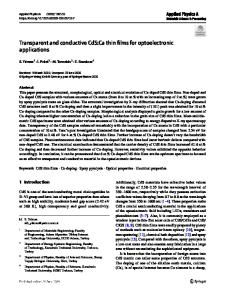Nanostructured Transparent Conductive Oxides for Photovoltaic Applications
- PDF / 800,275 Bytes
- 6 Pages / 612 x 792 pts (letter) Page_size
- 55 Downloads / 396 Views
Nanostructured Transparent Conductive Oxides for Photovoltaic Applications Roger E. Welser,1,2 Adam W. Sood,1,2,3 Jaehee Cho,3 E. Fred Schubert,3 Jennifer L. Harvey,4 Nibir K. Dhar,5 and Ashok K. Sood1,2 1
Magnolia Solar, Inc., 251 Fuller Road, CESTM- B250, Albany, NY 12203 Magnolia Optical Technologies, Inc., 52-B Cummings Park, Suite 314, Woburn, MA 01801 3 Rensselaer Polytechnic Institute, 110 Eighth Street, Troy, NY 12180 4 NYSERDA, 17 Columbia Circle, Albany, NY 12203 5 Defense Advanced Research Projects Agency, 3701 North Fairfax Drive, Arlington, VA 22203 2
ABSTRACT Oblique-angle deposition is used to fabricate indium tin oxide (ITO) optical coatings with a porous, columnar nanostructure. Nanostructured ITO layers with a reduced refractive index are then incorporated into antireflection coating (ARC) structures with a step-graded refractive index design, enabling increased transmittance into an underlying semiconductor over a wide range of wavelengths of interest for photovoltaic applications. Low-refractive index nanostructured ITO coatings can also be combined with metal films to form an omnidirectional reflector (ODR) structure capable of achieving high internal reflectivity over a broad spectrum of wavelengths and a wide range of angles. Such conductive high-performance ODR structures on the back surface of a thin-film solar cell can potentially increase both the current and voltage output by scattering unabsorbed and emitted photons back into the active region of the device. INTRODUCTION Transparent conductive oxides such as ITO are commonly used for a wide variety of applications, including liquid crystal displays (LCDs), light emitting diodes (LEDs), and thinfilm solar cells. Conventional ITO is a dense material with fixed refractive index characteristics that limit its performance as an optical coating. However, lower index ITO films have recently been demonstrated by employing an oblique angle deposition technique to form porous films with a columnar nanostructure [1-4]. In this work, we review the formation of nanostructured ITO films, and demonstrate the use of low index ITO layers in both ARC and ODR structures that can enhance photovoltaic (PV) device performance. OBLIQUE ANGLE DEPOSITION OF NANOSTRUCTURED ITO Oblique angle deposition is a technique that uses a physical-vapor deposition process, such as electron-beam evaporation, to deposit a material layer with a columnar nanostructure. In oblique angle deposition, the substrate is mounted inside the evaporation chamber at a nonnormal angle relative to the vapor flux. Initially, islands of evaporated material form on the substrate in random locations. Because the flux of evaporated material in a high-vacuum chamber flows from the source in only a straight line, and because the substrate is mounted at a non-normal angle to the direction of the flux, a shadow region forms behind each self-assembled island that newly arriving flux cannot reach [4]. Thus, the substrate is not uniformly coated, but instead columns begin to form on top of the island
Data Loading...











